What is a multi split system: operating principle + installation and connection rules
Agree, an air conditioner can make life a lot easier and make it much more comfortable. In summer it will provide coolness and a pleasant sleep, and in winter it will help keep you warm.But how to make a worthwhile choice? After all, the modern market offers thousands of models of climate control equipment. For example, the trend of recent years is a multi-split system, what is it, how does it differ from similar air conditioning systems?
If you listen to reviews about multi-splits, you can hear diametrically opposed opinions. Some are delighted, but it clearly did not live up to others’ hopes. Why is this happening? As a rule, due to a lack of understanding of the operating principle and technical features of the system as a whole, or due to improper installation and connection.
Let's try to figure out what a multi-split system is and how it works. Let's look at the advantages and disadvantages of this technique and talk about the intricacies of equipment installation.
The content of the article:
What is a multi-split system?
A multi-split system is a special climatic equipment designed for conditioning and maintaining certain climatic air parameters in rooms for various purposes. Consists of at least three elements.
There is always one outside compressor-condensing unit, which is installed outdoors, outside and mounted on the facade of the building. And at least two internal evaporator modules, which, in fact, cool/heat the air.

When installing this air conditioning system, it is necessary to take into account both the totality of the characteristics of all its devices and the technical capabilities of each of them.
External air conditioning unit
The main feature of the external module is its power. The performance of one unit must ensure the normal functioning of all internal devices in the same climate conditions.
As a rule, it is difficult to calculate it yourself, since the calculation is made on a differentiated scale. But to approximately determine the power rating, you just need to add up the indicators of each indoor unit. The resulting amount must be equal to the power of the external one.
But the result of this calculation will be relative, because the following values were not included in it:
- cooling capacity;
- operating modes;
- area of premises;
- climatic features of the region.
There are models of already assembled multi split systems. In them, the performance of the outdoor unit already implies a load of a fixed number of indoor modules.
After purchase, the system is ready for installation - you don’t need to calculate anything else.
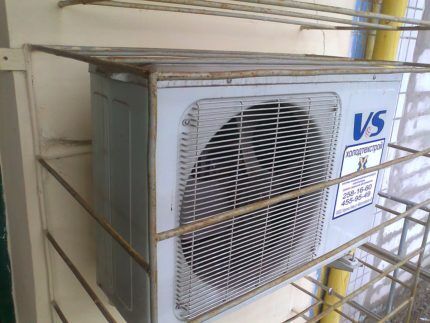
The advantage of stacked systems is the ability to select different types of air conditioners for any room.
This may be relevant when the purpose of these premises requires different volumes and air conditioning tasks. In this case, the development of the air conditioning system project should be entrusted to professionals.
Indoor units of multi-conditioner
The internal devices of a multi-split system are de facto no different from ordinary ones. The only difference is their number and the possibility of using several types of modules within one network.
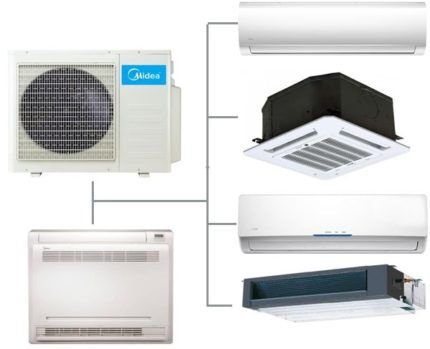
Types of air conditioners that can be used in the system:
The multi system makes it possible to use several types of internal devices without cluttering the façade with compressor and condenser boxes.
The principle of operation of a multi-split system
Technically, the operation of a multi-split system and two-component split system is the same, since each internal device has its own, separately dedicated trunk, leading to the outdoor unit.
Heating and cooling are provided due to phase transitions of the refrigerant from liquid to gaseous state and vice versa, due to pressure and temperature differences.
When freon is converted from liquid to gas, the air in the room is cooled, and the reverse process releases heat.
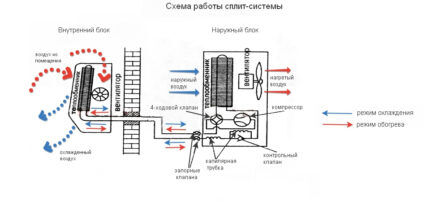
The movement of refrigerant from the outdoor unit to the indoor units occurs through two-pipe main channels. This technical feature also explains the main disadvantage of multi-split systems - the impossibility of simultaneous operation of air conditioners in different modes. Only heating or just cooling.
Advantages of a multi-system
The demand for multi-split systems is simply explained.
Their most important advantages:
- Aesthetics. There is no need to clutter the facade or walls of the house with dimensional boxes of the external unit, one for each internal device. One or two are enough, capable of providing the necessary microclimate indicators for the necessary rooms of an apartment or private house.
- Each air conditioner is configured remotely with an individual control panel.
- Ability to select different types of air conditioners to operate in one system. This way you can choose the optimal device for each room.
- Maximum noise insulation. Since the main source of noise - the compressor-condensing unit is mounted outside, and there is only one - the noise of operating air conditioners is virtually inaudible even with the windows open.
Moreover, the cost of such a multi-system is not much more expensive than an ordinary one.
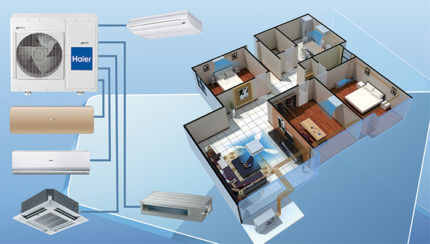
The combination of these advantages is often a very strong argument in favor of choosing a multi-split system.Even despite its obvious and not so obvious shortcomings.
Disadvantages of the climate system
A multi-split system is not ideal. It has its disadvantages that need to be taken into account.
This is first of all:
- complex installation. Each air conditioner must have its own channel to the external unit;
- higher price for equipment installation;
- impossibility of simultaneous operation of system air conditioners in different modes. For example, warm the air in one room and cool it in another.
There are disadvantages in any device. But, for example, choosing a compressor injector type and by installing it an order of magnitude lower than the internal modules, you can significantly reduce the amount of electricity consumed during system operation without losing its performance.
Installation of air conditioning system
Regardless of what building (wooden, brick) it is produced system installation, it is better to order these works to specialists.

The efficiency of the entire system will depend on the extent to which the technology for laying each of the channels is followed and the peculiarities of the selected types of internal modules are taken into account.
Typically, the entire workflow can be divided into stages:
- Drawing up a project - the location of all the main components and components of the system, the location of the main line and electrical wiring.
- Marking.
- Installation of electrical wiring.
- Installing/attaching the external unit box to the wall.
- Laying the main line.
- Installation of internal system modules.
- Filling the system with freon.
After connecting the multi-split system, it is mandatory to test all its performance indicators.
Equipment installation process
When the project is ready, the process of installing multisystem equipment begins, as well as laying and connecting communications.
First of all, the external unit is attached to the external wall on brackets at a distance from the internal modules no more than 20 meters. This is an average value; each system block from different manufacturers has its own maximum permissible distance from the compressor-condensing unit.
Having secured the block to the wall, mark the place where communications will be taken out of it - drainage, inter-block and power cables, two copper tubes from each internal module in insulation.
The next step is to mark the direction of the output location at a slight slope. When the drainage outlet is provided to the street, on average the slope is calculated in the range of 5 mm for each meter of the entire length of the route.
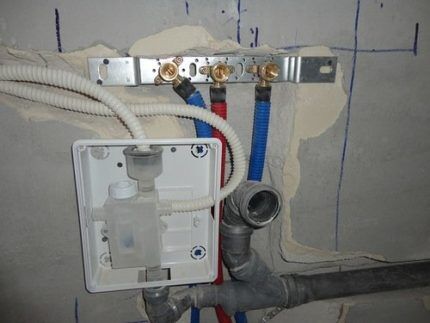
Along the marking lines, grooves are made for laying the main line, or a decorative box is applied along the entire length to the junction.
When laying a drainage system, you must adhere to the following standards:
- the slope of the horizontal sections should be 3%;
- turns and bends of the hose should not exceed 45º.
The cable laying from the KKB should go directly to the distribution panel. This is the most optimal option for energy distribution - it gives a certain autonomy to the system, making it independent of the operation and energy consumption capacity of other household appliances.
In addition, from an aesthetic point of view, it allows you to avoid cluttering the walls with cables, sockets, cords and plugs. And from the point of view of convenience, external units in each room will be switched on directly from the remote control.
Having installed the blocks of internal modules, the commissioning work itself begins. All communications are connected to the equipment modules, the flare nuts are tightened tightly, with force to achieve the required level of connection tightness.
When all elements of the system are connected and it is already closed, air and water are pumped out from the freon main line of the network.
The last actions of the installers are opening the external ports of the equipment, starting the refrigerant and testing the air conditioning system - checking operation in all modes at the equipment power limit.
Common installation mistakes
It happens that, after reading the installation instructions from the manufacturer, owners of multi-split systems that have not yet been installed entrust this work to amateurs.
In 90% of cases, this solution leads to installation errors:
- Installing the external unit of the air conditioner in the same plane as the internal devices reduces the performance of the entire system and increases energy consumption.
- Installing a compressor on the wall of a glazed balcony means there is a lack of air for heat exchange.
- Kinking of the pipes of the line through which the refrigerant circulates - a decrease in throughput, an increase in the load on the compressor.
- Installation of internal system modules above heating radiators or other heating devices.
- Poor quality of the rolling connection - the system will lose freon very quickly.
Not all installation errors are listed, because it happens that the system is not topped up with refrigerant, or the slope is incorrectly calculated, etc.
Therefore, saving on installation can lead to rapid breakdown of the system’s air conditioners.

In order for the installation to be reliable and the system to work properly, it is necessary to use specialized equipment during installation and have professional knowledge and skills.
This will ensure long service life and air conditioning efficiency in accordance with the parameters declared by the manufacturer. In addition, service centers provide a guarantee on the quality of their work. Therefore, if something goes wrong, they will be obliged to correct installation errors at their own expense.
The problems listed above are the first signs of a device malfunction. Air conditioning system service specialists recommend that if problems are detected, immediately contact specialized organizations for diagnosis and repair.
A problem identified in a timely manner can be solved with a small repair or replacement of a spare part. Ignoring it can lead to rapid resource exhaustion and breakdown of the entire system.
Conclusions and useful video on the topic
The operating principle of a multi-split system is presented in the following video:
A comparison of split and multi-split systems can be seen in the following video:
Choosing an air conditioning system, especially in residential areas, is a responsible matter. After all, any device has its own characteristics and technical capabilities.
The main thing to remember before making a responsible decision is the need to part with rose-colored glasses and boldly look at the advantages and disadvantages of the system you like. Indeed, depending on the needs of the user, they can change places and from a minus become a plus and vice versa.
If you have experience using a multi-split system, please share it with our users



